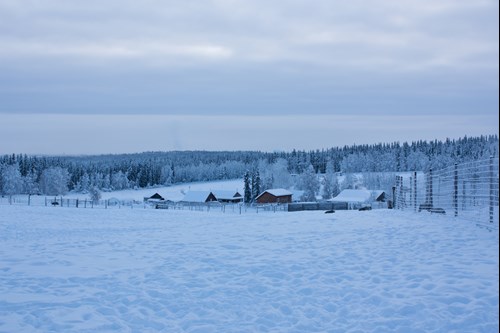Our research group at Aarhus University focuses on studying the movement ecology, physiology and energetics of wild muskoxen in northeast Greenland. Larissa is analysing GPS and activity data collected from 30 individual muskox females during her PhD project, exploring the drivers and plasticity of different foraging and movement strategies under varying environmental conditions. Jean-Pierre is using energetic models to investigate how muskox use energy from food to fuel different physiological processes and will try to link environmental change to individual fitness during his post-doc. Thanks to north2north funding, we were able to visit and enhance our collaboration with the Large Animal Research Station (LARS) run by the University of Alaska Fairbanks, an ideal facility and partner institution for both our projects.

Working with the captive muskoxen held at LARS offered a unique opportunity to simultaneously collect activity and behavioural data from direct observations, which is essential to validate and improve the models and results based on the data from free-roaming muskoxen in Greenland. Activity data allows us to get a detailed picture of when the animals are resting, feeding, walking or performing any other behaviours. Usually, it is not possible to visually validate such activity data when working with wild animals, especially in regions as remote as northeast Greenland: you can make assumptions about what kind of behaviours you think the data reflects, but you can’t observe what the animals are actually doing. Thanks to three captive muskox females at LARS, we can now compare the data to observed behaviours which we recorded on video. By filming both during a first visit to LARS in January and during our second visit in August, we were able to capture different seasonal behaviours, for example walking in deep snow or grazing in summer. The resulting paper from this work will serve as an important basis and reference for all subsequent publications during Larissa’s PhD, setting the stage for interesting new insights into the movement ecology of this important Arctic species.
In a meeting with the veterinarians and researchers working at LARS, we were further able to discuss important issues regarding on-going work and developed many ideas for joint future research projects. Data from the captive animals at LARS is extremely valuable for constructing energetic models, as detailed data on growth, food intake, and reproduction is usually hard to acquire from wild muskoxen. Hence it is crucial data to validate our models to make sure that our predictions for various aspects of muskox physiology and ecology are realistic. Once validated, the model can be applied to the wild population in Greenland and abroad to understand how movement, climate change, and various stressors can influence muskox population dynamics.
Working with the staff and researchers at LARS was a very valuable exchange, providing us with important input to our research and strengthening the collaboration between two institutions invested in studying muskoxen.
Once we were finished with our work in Fairbanks, we continued to Anchorage, where we met with another collaborator who is modelling snow conditions for northeast Greenland, i.e. providing us with important environmental data to which we will relate the movements and behaviours of the wild muskoxen. Meeting with her in person was very insightful and another highlight of our trip.
Many thanks to the north2north funding for this great support of our work!
